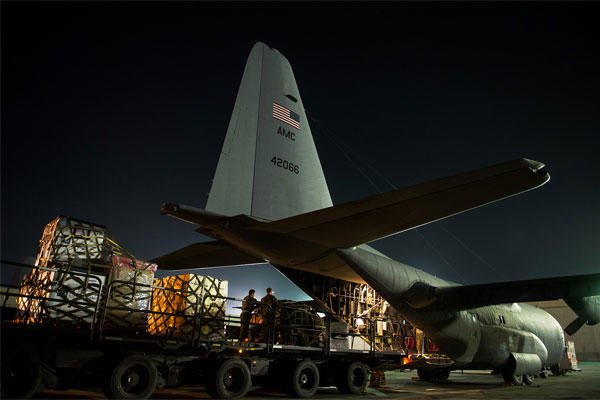BAGRAM AIRFIELD, Afghanistan -- A small group of people leave their office and pile into a vehicle.
Twelve hours later, they've travelled more than 800 miles - roughly the distance from Seattle to San Francisco - stopped several times in the middle of nowhere, picked up a few passengers who speak very little English, overcome engine trouble and evaded fire from semi-automatic weapons.
While this may sound like one epic road trip, or the plot of an upcoming "Hangover" sequel, it's just a day in the life of C-130 aircrew from the 774th Expeditionary Airlift Squadron.
"Every flight is unique, and anything can happen," said Airman 1st Class Luke Tucciarone, 774th EAS loadmaster. "Even if you're doing the same exact kind of mission, day in and day out, every flight is different."
There might be no such thing as a typical flight for Airmen assigned to the squadron, but this sequence of events isn't uncommon for what is known as an "air/land" mission.
After a pre-flight briefing, the aircrew leaves the squadron and walks down the flightline to a C-130H Hercules aircraft. This team, along with ground support personnel, ensures the aircraft is properly inspected, fueled and ready to fly. Cargo and passengers are then brought on board - anything from food to fuel to armored vehicles, and anyone from U.S. Army soldiers to Defense Department civilians or third-country nationals.
Once everything is secure, the C-130 takes flight, headed to one or more forward operating bases (FOBs), often in remote parts of Afghanistan. Once the cargo has been delivered, it's either on to the next FOB, or back to Bagram for the next mission. Along the way are potential challenges to overcome, including both aircraft maintenance issues and small arms fire.
Maj. Jake Hiles, 774th EAS pilot, said these "air/land" missions comprise about 80 percent of the squadron's sorties. And in Afghanistan, there's no aircraft better suited to fly them than the affectionately nicknamed "Mighty Herc."
"We can get to all FOBs, get to them faster, carry more cargo than smaller aircraft, and can land where larger aircraft can't," Hiles said. "This is C-130 country."
The versatile aircraft is very capable of operating in challenging environments here, such as short runways and dirt airstrips, he said.
"We're putting all of our training to use here in this environment," Hiles said. "Flying here is what we train for at home."
The aircraft's capabilities also allow 774th Airmen to complete two other important missions: airdrops and medical evacuations.
Maj. Matt Eckles, 774th EAS pilot, said airdrop missions in Afghanistan are critical - especially to those at small, remote bases.
"For every one of these missions that we do, that's another convoy that doesn't have to be on the roads trying to resupply that FOB, and exposing themselves to potential IED threats and all the other fun things that Afghanistan has to offer," he said. "The FOBs that really count on us, the ones that are really out there in the middle of nowhere, they're the ones that are in the fight every day and they're counting on us for that resupply so they can do their mission."
"We're in an enabler role and our mission is sustainment ... we're trying to keep these guys going," Eckles said. "Delivering the 'beans, bullets and fuel' is a very rewarding job."
Regardless of the type of mission, it takes a real team effort to succeed, he said.
"From the loadmasters in the plane to all the support troops like maintenance and aircrew flight equipment, those guys bust their butts every day trying to help us get the missions off the ground," Eckles said. "We just quite simply couldn't do any of it without them."
"The loadmasters have a special role as enlisted aircrew ... they're kind of a rare breed," he said. "What they do in the back requires very special training and it's not an easy job."
"I'm lucky," Eckles said. "I've got some extremely talented loadmasters, they're extremely good at their jobs. They make my job up front just that much easier."
The squadron's missions have a significant impact for U.S. and coalition forces in Afghanistan, said Lt. Col. Brian Watkins, 774th EAS commander. At the halfway point of his deployment, he said, the men and women of the squadron have flown more than 800 hours during 1,300 sorties - transporting more than 6,000 tons of cargo, and moving approximately 13,000 passengers.
"This squadron epitomizes what tactical combat airlift is all about," he said. "This unit is comprised of seven units from around the Air Force who have come together to execute our wartime mission.
"I'm amazed daily by the work the men and women of the 774th EAS contribute to the establishment of security and stability in Afghanistan," Watkins said. "Not just the aircrews, but AFE, Aviation Resource Management, intelligence, and maintenance personnel ... their concerted effort make the mission go."
The colonel said, "It's amazing to see our training validated on a daily basis and see the real effects. Whether it's delivering lifesaving airlift to critically injured military members, or airdropping 20,000 pounds of supplies to a FOB in an austere region of Afghanistan, this squadron gets it done."
When the shift is over and the day's - or night's - missions are complete, the Airmen return to Bagram for some well-earned crew rest. But there's another aircrew just beginning their day, preparing to complete another set of flights. A sign outside one squadron appropriately reads, "C-130 Land, Open 24 Hours."






























